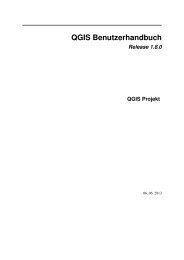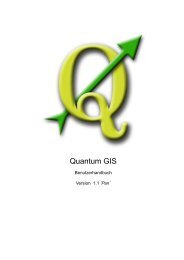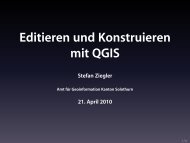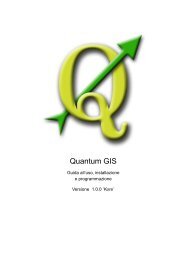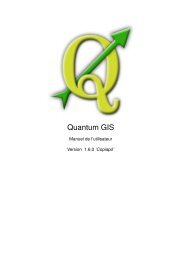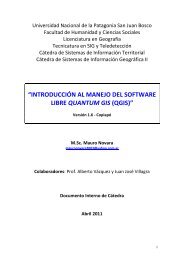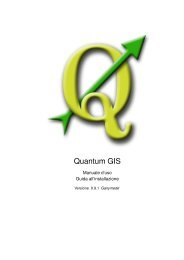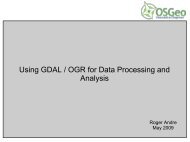QGIS User Guide - OSGeo Download Server
QGIS User Guide - OSGeo Download Server
QGIS User Guide - OSGeo Download Server
Create successful ePaper yourself
Turn your PDF publications into a flip-book with our unique Google optimized e-Paper software.
12 USO DEI PLUGIN CORE <strong>QGIS</strong><br />
12.14. OpenStreetMap Plugin<br />
In recent years the OpenStreetMap project has gained popularity because in many countries no free<br />
geo data such as digital roadmaps are available. Target of the OSM project is to create a free editable<br />
map of the world from GPS data, aerial photography or simply from local knowledge. To support this<br />
idea <strong>QGIS</strong> provides a plugin that enables its users to work with OSM data.<br />
The plugin provides all basic functionalities for OSM data manipulation, such as data loading, importing,<br />
saving, downloading, editing and uploading data back to the OpenStreetMap server. While<br />
implementing OSM plugin an inspiration was taken from existing OSM data editors. The purpose was<br />
to combine their functionalities to get the best possible result.<br />
The following subsection gives a brief introduction to principles of the OSM project. If you are not<br />
interested in information on OSM just skip the next section. Parts of the following paragraphs are<br />
copied from the OpenStreetMap web site at http://www.openstreetmap.org.<br />
The OpenStreetMap project<br />
OpenStreetMap is a project to create a free editable map of the world. The maps are created using<br />
data from portable GPS devices, aerial photography, other free sources or simply from local knowledge.<br />
The project was started because most maps have legal or technical restrictions on their use,<br />
holding back people from using them in creative, productive, or unexpected ways. Both rendered images<br />
and the vector dataset of OSM are available for download under a Creative Commons Attribution<br />
ShareAlike 2.0 licence.<br />
OpenStreetMap was inspired by sites such as Wikipedia - the map display (see Figure 75) features<br />
a prominent Edit tab and a full revision history is maintained. Registered users can upload GPS<br />
track logs and edit the vector data using the given editing tools.<br />
OSM data primitive is an object class that can be stored via the API in the server. The three supported<br />
types of data are: Node, Way and Relation.<br />
• A node is a latitude/longitude pair of coordinates. It is used as building a block for other features<br />
and as a feature itself (Points Of Interest), if they are tagged as required.<br />
• A way is a list of at least two nodes that describe a linear feature such as a street, or similar.<br />
Nodes can be members of multiple ways.<br />
• A relation is a group of zero or more primitives with associated roles. It is used to specify<br />
relationships between objects, and may also model an abstract object.<br />
Several different logical features in a common map (’Point Of Interest’, ’Street’, ’Tram Line’, ’Bus Stop’<br />
etc.) are defined by these primitives. Map features are well-known in the OSM community and are<br />
stored as tags, based of a key and a value. OSM is usually distibuted in XML format. XML payload is<br />
used for the communication with the OSM server as well.<br />
<strong>QGIS</strong> 1.4.0 <strong>User</strong> <strong>Guide</strong> 186



